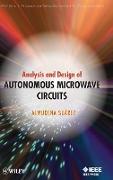Analysis and Design of Autonomous Microwave Circuits
BücherAngebote / Angebote:
Presents simulation techniques that substantially increase designers' control over the oscillationin autonomous circuits
This book facilitates a sound understanding of the free-running oscillation mechanism, the start-up from the noise level, and the establishment of the steady-state oscillation. It deals with the operation principles and main characteristics of free-running and injection-locked oscillators, coupled oscillators, and parametric frequency dividers.
Analysis and Design of Autonomous Microwave Circuits provides:
* An exploration of the main nonlinear-analysis methods, with emphasis on harmonic balance and envelope transient methods
* Techniques for the efficient simulation of the most common autonomous regimes
* A presentation and comparison of the main stability-analysis methods in the frequency domain
* A detailed examination of the instabilization mechanisms that delimit the operation bands of autonomous circuits
* Coverage of techniques used to eliminate common types of undesired behavior, such as spurious oscillations, hysteresis, and chaos
* A thorough presentation of the oscillator phase noise
* A comparison of the main methodologies of phase-noise analysis
* Techniques for autonomous circuit optimization, based on harmonic balance
* A consideration of different design objectives: presetting the oscillation frequency and output power, increasing efficiency, modifying the transient duration, and imposing operation bands
Analysis and Design of Autonomous Microwave Circuits is a valuable resource for microwave designers, oscillator designers, and graduate students in RF microwave design.
Lieferbar in ca. 10-20 Arbeitstagen




